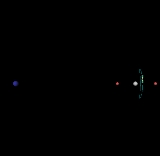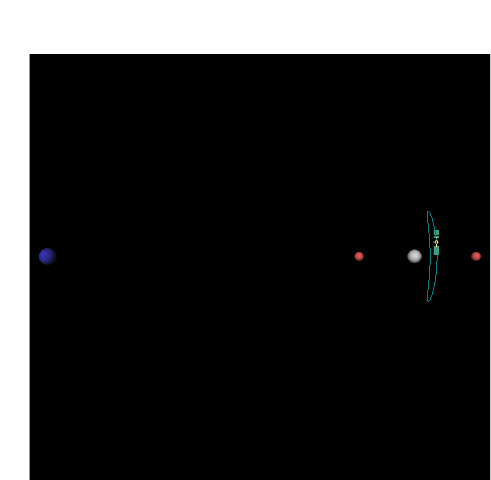
Halo orbit
Encyclopedia
A halo orbit is a periodic, three-dimensional orbit
near the , , or Lagrange points in the three-body problem of orbital mechanics. A spacecraft in a halo orbit does not technically orbit the Lagrange point itself (which is just an equilibrium point with no mass), but travels in a closed, repeating path near the Lagrange point. Halo orbits are the result of a complicated interaction between the gravitational pull of the two planetary bodies and the coriolis and centrifugal accelerations on a spacecraft. Halo orbits exist in many three-body systems, such as the Sun
–Earth
system and the Earth–Moon
system. Continuous "families" of both Northern and Southern halo orbits exist at each Lagrange point. Because halo orbits tend to be unstable, stationkeeping
is required to keep a satellite on the orbit.

The first mission to use a halo orbit was ISEE-3, launched in 1978. It traveled to the Sun–Earth point and remained there for several years. The next mission to use a halo orbit was SOHO, a joint ESA and NASA
mission to study the Sun, which arrived at Sun–Earth in 1996. It used an orbit similar to ISEE-3. Although several other missions since then have traveled to Lagrange points, they typically have used non-periodic orbits (also called Lissajous orbit
s) that are slightly different from halo orbits.
Farquhar used analytical expressions to represent halo orbits, but Kathleen Howell
showed that more precise trajectories could be computed numerically. The most recent mission to use a halo orbit was Genesis, launched in 2001, which also pioneered the use of Dynamical systems theory
to find low-energy trajectories to and from the halo orbit.
Orbit
In physics, an orbit is the gravitationally curved path of an object around a point in space, for example the orbit of a planet around the center of a star system, such as the Solar System...
near the , , or Lagrange points in the three-body problem of orbital mechanics. A spacecraft in a halo orbit does not technically orbit the Lagrange point itself (which is just an equilibrium point with no mass), but travels in a closed, repeating path near the Lagrange point. Halo orbits are the result of a complicated interaction between the gravitational pull of the two planetary bodies and the coriolis and centrifugal accelerations on a spacecraft. Halo orbits exist in many three-body systems, such as the Sun
Sun
The Sun is the star at the center of the Solar System. It is almost perfectly spherical and consists of hot plasma interwoven with magnetic fields...
–Earth
Earth
Earth is the third planet from the Sun, and the densest and fifth-largest of the eight planets in the Solar System. It is also the largest of the Solar System's four terrestrial planets...
system and the Earth–Moon
Moon
The Moon is Earth's only known natural satellite,There are a number of near-Earth asteroids including 3753 Cruithne that are co-orbital with Earth: their orbits bring them close to Earth for periods of time but then alter in the long term . These are quasi-satellites and not true moons. For more...
system. Continuous "families" of both Northern and Southern halo orbits exist at each Lagrange point. Because halo orbits tend to be unstable, stationkeeping
Orbital stationkeeping
In astrodynamics orbital station-keeping is a term used to describe the orbital maneuvers made by thruster burns that are needed to keep a spacecraft in a particular assigned orbit.For many Earth satellites the effects of the non-Keplerian forces, i.e...
is required to keep a satellite on the orbit.

Definition and history
Robert W. Farquhar first used the name "halo" for these orbits in his 1968 Ph.D. thesis. Farquhar advocated using spacecraft in a halo orbit on the far side of the Moon (Earth–Moon ) as a communications relay station for an Apollo mission to the far side of the Moon. A spacecraft in such a halo orbit would be in continuous view of both the Earth and the far side of the Moon. In the end, neither a communication link satellite nor an Apollo co-mission positioned at for a far side Apollo lunar landing ever took flight.The first mission to use a halo orbit was ISEE-3, launched in 1978. It traveled to the Sun–Earth point and remained there for several years. The next mission to use a halo orbit was SOHO, a joint ESA and NASA
NASA
The National Aeronautics and Space Administration is the agency of the United States government that is responsible for the nation's civilian space program and for aeronautics and aerospace research...
mission to study the Sun, which arrived at Sun–Earth in 1996. It used an orbit similar to ISEE-3. Although several other missions since then have traveled to Lagrange points, they typically have used non-periodic orbits (also called Lissajous orbit
Lissajous orbit
In orbital mechanics, a Lissajous orbit, , named after Jules Antoine Lissajous, is a quasi-periodic orbital trajectory that an object can follow around a Lagrangian point of a three-body system without requiring any propulsion. Lyapunov orbits around a libration point are curved paths that lie...
s) that are slightly different from halo orbits.
Farquhar used analytical expressions to represent halo orbits, but Kathleen Howell
Kathleen Howell
Kathleen Howell is a professor at Purdue University in the School of Aeronautical and Aerospace Engineering.She is a 1984 winner of the 1984 Presidential Young Investigator Award, presented to her at the White House by Ronald Reagan, and the 2004 recipient of the Dirk Brouwer Award from the...
showed that more precise trajectories could be computed numerically. The most recent mission to use a halo orbit was Genesis, launched in 2001, which also pioneered the use of Dynamical systems theory
Dynamical systems theory
Dynamical systems theory is an area of applied mathematics used to describe the behavior of complex dynamical systems, usually by employing differential equations or difference equations. When differential equations are employed, the theory is called continuous dynamical systems. When difference...
to find low-energy trajectories to and from the halo orbit.
See also
- Lissajous orbitLissajous orbitIn orbital mechanics, a Lissajous orbit, , named after Jules Antoine Lissajous, is a quasi-periodic orbital trajectory that an object can follow around a Lagrangian point of a three-body system without requiring any propulsion. Lyapunov orbits around a libration point are curved paths that lie...
, another Lagrangian-point orbit. - James Webb Space TelescopeJames Webb Space TelescopeThe James Webb Space Telescope , previously known as Next Generation Space Telescope , is a planned next-generation space telescope, optimized for observations in the infrared. The main technical features are a large and very cold 6.5 meter diameter mirror, an observing position far from Earth,...
will be in a halo orbit around L2 for the Sun–Earth system.
Links
- CDS140B: Computation of Halo Orbit
- SOHO - The Trip to the L1 Halo Orbit
- Low Energy Interplanetary Transfers Using Halo Orbit Hopping Method with STK/Astrogator
- Gaia's Lissajous Type Orbit - This is a Lissajous-type orbit (i.e. a near-circular ellipse or "halo")

